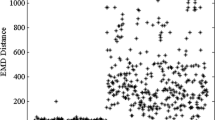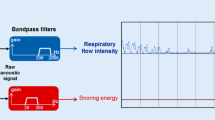Abstract
This study presents a rule-based method for automated, real-time snoring detection using nasal pressure recordings during overnight sleep. Although nasal pressure recordings provide information regarding nocturnal breathing abnormalities in a polysomnography (PSG) study or continuous positive airway pressure (CPAP) system, an objective assessment of snoring detection using these nasal pressure recordings has not yet been reported in the literature. Nasal pressure recordings were obtained from 55 patients with obstructive sleep apnea. The PSG data were also recorded simultaneously to evaluate the proposed method. This rule-based method for automatic, real-time snoring detection employed preprocessing, short-time energy and the central difference method. Using this methodology, a sensitivity of 85.4 % and a positive predictive value of 92.0 % were achieved in all patients. Therefore, we concluded that the proposed method is a simple, portable and cost-effective tool for real-time snoring detection in PSG and CPAP systems that does not require acoustic analysis using a microphone.




Similar content being viewed by others
References
Al-Khalidi FQ, Saatchi R, Burke D, Elphick H, Tan S (2011) Respiratory rate monitoring methods: a review. Pediatr Pulmonol 46:523–529
Antonescu-Turcu A, Parthasarathy S (2010) CPAP and Bi-level PAP therapy: new and established roles. Respir Care 55:1216–1229
Ayappa I, Norman RG, Krieger AC, Rosen A, O’malley RL, Rapoport DM (2000) Non-invasive detection of respiratory effort-related arousals (RERAs) by a nasal cannula/pressure transducer system. Sleep 23:763–771
Azarbarzin A, Moussavi ZM (2011) Automatic and unsupervised snore sound extraction from respiratory sound signals. IEEE Trans Biomed Eng 58:1156–1162
Azarbarzin A, Moussavi Z (2013) Intra-subject variability of snoring sounds in relation to body position, sleep stage, and blood oxygen level. Med Biol Eng Comput 51:429–439
Banno K, Kryger MH (2007) Sleep apnea: clinical investigations in humans. Sleep Med 8:400–426
Cavusoglu M, Kamasak M, Erogul O, Ciloglu T, Serinagaoglu Y, Akcam T (2007) An efficient method for snore/nonsnore classification of sleep sounds. Physiol Meas 28:841–853
Dafna E, Tarasiuk A, Zigel Y (2013) Automatic detection of whole night snoring events using non-contact microphone. PLoS ONE 8:e84139
Dalmasso F, Prota R (1996) Snoring: analysis, measurement, clinical implication and applications. Eur Respir J 9:146–159
de Almeida FR, Ayas NT, Otsuka R, Ueda H, Hamilton P, Ryan FC, Lowe AA (2006) Nasal pressure recordings to detect obstructive sleep apnea. Sleep Breath 10:62–69
de Oliveira CBG, da Silva DGV, Moriya HT, Skomro R, Alencar AM, Lorenzi-Filho G (2011) Snoring: the silent signal in sleep medicine. Sleep Sci 4:21–27
Duckitt WD, Tuomi SK, Niesler TR (2006) Automatic detection, segmentation and assessment of snoring from ambient acoustic data. Physiol Meas 27:1047–1056
Ekici M, Ekici A, Keles H, Akin A, Karlidag A, Tunckol M, Kocyigit P (2008) Risk factors and correlates of snoring and observed data. Sleep Med 9:290–296
Gottlieb DJ, Yai Q, Redline S, Ali T, Mahowald MW (2000) Does snoring predict sleepiness independently of apnea and hypopnea frequency? Am J Respir Crit Care Med 162:1512–1517
Grover SS, Pittman SD (2008) Automated detection of sleep disordered breathing using a nasal pressure monitoring device. Sleep Breath 12:339–345
Hosselet JJ, Norman RG, Ayappa I, Rapoport DM (1998) Detection of flow limitation with a nasal cannula/pressure transducer system. Am J Respir Crit Care Med 157:1461–1467
Iber C, Ancoli-Israel S, Chesson AL Jr, Quan SF (2007) The AASM manual for the scoring of sleep and associated events: rules, terminology and technical specifications, 2nd edn. American Academy of Sleep Medicine, Westchester
Jané R, Solà-Soler J, Fiz J A, Morera J (2000) Automatic detection of snoring signals: validation with simple snorers and OSAS patients. In: Proceedings of 22nd annual EMBS international conference, pp 3129–3131
Karunajeewa AS, Abeyratne UR, Hukins C (2008) Silence-breathing-snore classification from snore-related sounds. Physiol Meas 29:227–243
Lee H-K, Lee J, Kim H, Lee K-J (2013) Automatic snoring detection from nasal pressure data. Conf Proc IEEE Eng Med Biol Soc 2013:6870–6872
Nakano H, Furukawa T, Nishima S (2008) Relationship between snoring sound intensity and sleepiness in patients with obstructive sleep apnea. J Clin Sleep Med 4:551–556
Navajas D, Duviview C, Farré R, Peslin R (2000) A simplified method for monitoring respiratory impedance during continuous positive airway pressure. Eur Respir J 15:185–191
Prasad B, Carley DW, Herdegen JJ (2010) Continuous positive airway pressure device-based automated detection of obstructive sleep apnea compared to standard laboratory polysomnography. Sleep Breath 14:101–107
Pevernagie D, Aarts RM, De Mayer M (2010) The acoustic of snoring. Sleep Med Rev 14:131–144
Rofail LM, Wong KK, Unger G, Marks GB, Grunstein RR (2010) The role of single-channel nasal airflow pressure transducer in the diagnosis of OSA in the sleep laboratory. J Clin Sleep Med 6:349–356
Sériès F, Narc I (1999) Nasal pressure recording in the diagnosis of sleep apnoea hypopnoea syndrome. Thorax 54:506–510
Shin H, Cho J (2014) Unconstrained snoring detection using a smartphone during ordinary sleep. Biomed Eng Online 13:116
Solà-Soler J, Jané R, Fiz J A, Morera J (2000) Towards automatic pitch detection in snoring signals. In: Proceedings of 22nd annual EMBS international conference, pp 2974–2976
Steltner H, Staats R, Timmer J, Vogel M, Guttmann J, Matthys H, Christian Virchow J (2002) Diagnosis of sleep apnea by automatic analysis of nasal pressure and forced oscillation impedance. Am J Respir Crit Care Med 165:940–944
Vaughn BV, Giallanza P (2008) Technical review of polysomnography. Chest 134:1310–1319
Wilson K, Stoohs RA, Mulrooney TF, Johnson LJ, Guilleminault C, Huang Z (1999) The snoring spectrum: acoustic assessment of snoring sound intensity in 1,139 individuals undergoing polysomnography. Chest 115:762–770
Yadollahi A, Moussavi Z (2010) Automatic breath and snore sounds classification from tracheal and ambient sound recordings. Med Eng Phys 32:985–990
Acknowledgments
This work was supported by the Technology Innovation Program (10040408, Development of CPAP for sleep apnea) funded by the Ministry of Trade, Industry and Energy (MOTIE, Korea).
Author information
Authors and Affiliations
Corresponding author
Additional information
An erratum to this article is available at http://dx.doi.org/10.1007/s11517-016-1588-4.
Rights and permissions
About this article
Cite this article
Lee, HK., Kim, H. & Lee, KJ. Nasal pressure recordings for automatic snoring detection. Med Biol Eng Comput 53, 1103–1111 (2015). https://doi.org/10.1007/s11517-015-1388-2
Received:
Accepted:
Published:
Issue Date:
DOI: https://doi.org/10.1007/s11517-015-1388-2




